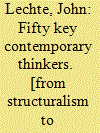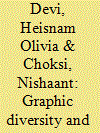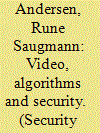|
|
|
Sort Order |
|
|
|
Items / Page
|
|
|
|
|
|
|
| Srl | Item |
| 1 |
ID:
050990


|
|
|
|
|
| Publication |
London, Routledge, 2003.
|
| Description |
xi, 251p.
|
| Standard Number |
9780415074087
|
|
|
|
|
|
|
|
|
|
|
|
Copies: C:1/I:0,R:0,Q:0
Circulation
| Accession# | Call# | Current Location | Status | Policy | Location |
| 047925 | 190.904/LEC 047925 | Main | On Shelf | General | |
|
|
|
|
| 2 |
ID:
190164


|
|
|
|
|
| Summary/Abstract |
This article describes how attention to the uses, attitudes, and perceptions of various scripts may provide a dynamic picture of the construction of ethnic identity beyond the framework of ethnic conflict in the northeastern Indian state of Manipur. Currently, the languages of Manipur are written in several scripts such as Eastern Brahmi, Roman, Meitei Mayek, and Zo script. Drawing on data collected from interviews of college-age residents of Manipur from different ethnic backgrounds, representatives of cultural organizations in the hills and plains, and from analysis of social, print, and audio-visual media, the article argues that the alignments between script, ethnic identity, and territory are not stable but change in relation to individuals’ or organizations’ positionality towards broader social and political ideologies. In graphically diverse regions such as Manipur, script serves as a semiotic resource through which people can incorporate distinct, but overlapping, ideas of belonging in the construction of ethnic identity.
|
|
|
|
|
|
|
|
|
|
|
|
|
|
|
|
| 3 |
ID:
140753


|
|
|
|
|
| Summary/Abstract |
The author analyzes a highly specific geopolitical phenomenon—geopolitical self-identification of the Central Asian countries with the help of geographic images, symbols, and signs used to prove their importance on the international arena and at the regional level in particular. In his analysis the author uses a constructivist approach to the efforts to fit several geographic descriptions into a geopolitical context combined, to a certain extent, with a realistic approach expressed by the term “geopolitical semiotics.”
|
|
|
|
|
|
|
|
|
|
|
|
|
|
|
|
| 4 |
ID:
111467


|
|
|
|
|
| Publication |
2011.
|
| Summary/Abstract |
This paper analyses the meaning of poverty in different periods, as defined by the use of language. It examines the creation of codes as a representation of escape from poverty. The author shows variations in the meaning of poverty in Thai society as three overlapping layers: deprivation, used to evaluate the poor in a straightforward way; development poverty, used for negotiating with the government in the sense of receiving development benefits; and social poverty, used to set social hierarchies. All three meanings have become integrated and have been selectively used in differing contexts in everyday life. However, they each share the feature of comparing differing degrees of wealth relating directly to divisions in social class. This reflects people's awareness of the poverty gap in Thailand.
|
|
|
|
|
|
|
|
|
|
|
|
|
|
|
|
| 5 |
ID:
154750


|
|
|
|
|
| Summary/Abstract |
Digital videos increasingly sustain new and older imagined communities (and enmities), and make battlefields, unfolding terror plots and emergencies public. Yet digital videos mediate security articulations following logics that are radically different from those of journalistically edited media, with consequences for how we should think of security articulation in new visual media. This article analyses how, in digital video, the combination of visible facts and the remediation logics of algorithmically governed video platforms – such as YouTube and Facebook – allow for new types of security articulations. It argues that digital video can be understood as a semiotic composite where the material semiotics of media technologies, calculated publics and spectators combines with the political semiotics of audio-visual media to condition how video articulations work as political agency. A powerful video-mediated security articulation, the #neda videos from the 2009 Iranian post-election crisis, illustrates how security articulation in digital video is not tied to the authority of a speaker and does not contain the promise of an immediate, illocutionary security effect. Drawing on securitization theory and Butler’s critique of speech act theory, this article understands such video articulations as post-sovereign security articulations.
|
|
|
|
|
|
|
|
|
|
|
|
|
|
|
|
|
|
|
|
|